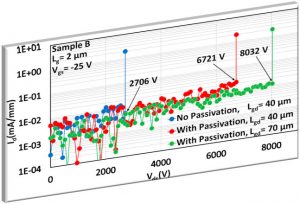Passivation pushes gallium oxide transistor to over 8kV
Passivation pushes gallium oxide transistor to over 8kV
The proof-of-concept device was passivated with the high field strength epoxy polymer SU-8. Without passivation, a similar transistor scored 2.7kV.
This un-passivated voltage is also remarkable, as the same team only managed to reach 1.8kV in 2018 with passivation (using less-robust Fluorinert in that case).
The transistor was a field-plate design – which also increases operating voltage.
 8kV was achieved with a a gate-drain length of 70μm. The un-passivated transistor had a 40μm gate-drain length, and achieved 6.7kV once passivated – 1.69MV/cm average field strength.
8kV was achieved with a a gate-drain length of 70μm. The un-passivated transistor had a 40μm gate-drain length, and achieved 6.7kV once passivated – 1.69MV/cm average field strength.
Simulations suggest the transistor design has a field strength of more than 10MV/cm. “These simulated field strengths are impressive. However, they need to be verified by direct experimental measurements,” said research engineer Uttam Singisetti.
On-resistance in the research devices was high, though to be due to damage caused by during processing that could be optimised in future devices.
Gallium oxide, specifically β-Ga2O3, is a contender for future power transistors. Its high bandgap (4.5-4.9eV, compared with ~3.4eV for SiC, ~3.3 for GaN and ~1.1 for silicon) puts it well ahead for high-voltage use.
The material delivers a temptingly high score in Baliga’s figure-of-merit – a predictor of device on-resistance against operating voltage – second only to diamond, and thrashing GaN or SiC.
However, it also has appalling thermal conductivity – worse than even sapphire – leading some to conclude that, if the material finds use, it will be in high-voltage applications low current applications, with high voltage high current following only if suitable cooling techniques, such as micro-channel fluidics, can be developed.
Comments